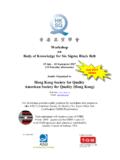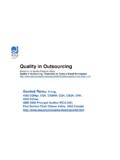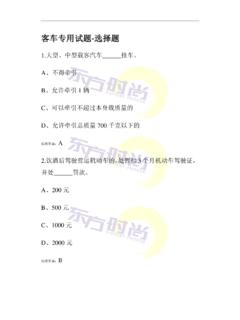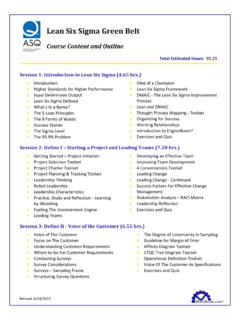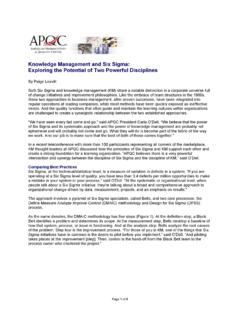Transcription of System Approach to Innovation Management - HKSQ
1 24 Jan 2015 System Approach to Innovation ManagementLotto LaiManager, (Quality System )Corporation DevelopmentIntegration of Quality and Innovation Management SystemContentIntroduction of new version of QMS ISO9001:2015 Introduction of Innovation Management System (InnoMS) based on PD CEN/TS 16555-1:2013 Integration Approach from QMS to InnoMSIntroductionQuality Making things betterInnovation Making better thingsQuality Management - are coordinated activities to direct and control an organization with regard to qualityQuality Management System - is a set of elements of an organization s Management System concerned with managing qualityQuality & Innovation Management System - is a set of elements of an organization s Management System for making better things betterMain Change in ISO9001.
2 2015 (DIS version)Adoption ISO Directives Annex SL a high-level structure (HLS)Risk-based ThinkingFewer prescribed requirementsLess emphasis on documentsDefine the boundaries of the QMSI ncrease leadership requirementsThe Revised Quality PrinciplesISO Directives Annex SL a high-level structure (HLS)ClausesClauses1. Scope6. Planning- Actions to address risks & opportunities- Objectives and plans to achieve them2. Normative references7. Support- Resources - Awareness- Competence - Communication- Documented information3. Terms and definition8. Operations- Operation planning and control4. Context of organization-Understanding the organization and its context-Needs and expectations of interested parties-Determining the scope- Management System9.
3 Performance Evaluation- Monitoring, measurement, analysis & evaluation- Internal audit- Management review5. Leadership- Leadership and commitment- Policy- Roles, responsibility and authority10. Improvement- Non-conformity and corrective action- Continual ImprovementSome changes based on DIS Products and services instead of product External provision of products and services instead of purchasing includes outsourced processes Documented information instead of Documented procedures and records New Clause Context of the Organization (external & internal factors)Identification of interested parties Actions to address risks & opportunities Organization knowledge Improving products and services to meet know and predicted requirements Model of process-based QMSI nnovation of Management System (InnoMS) StandardsBS 7000-1:2008.
4 Guide to managing innovationPD CEN/TS 16555-1:2013: Innovation Management Part 1: Innovation Management SystemInvention vs InnovationThe distinction between Invention and Innovation is that invention is the creation of a new idea or concept, and Innovation is turning the new concept into commercial success or widespread 7000-1:2008 Guide to managing innovationBS 7000-1, Guide to managing Innovation new edition April 2008gives guidance specifically in the design and development of innovative and competitive products that satisfies customers perceived needs and aspirations in the long-term futureUK Government focus: raise Innovation capability in business for benefit of economyBS 7000-1.
5 2008 Innovation ( )<ideas> successful exploitation of new ideas<process> introduction of changes that are significant departures from the usual way of doing things<product> transformation of an idea into a novel product, operational process or new service<techniques, materials> employment of design or construction techniques, or materials, that do not have a proven history of performance or are not covered by an organization s current practicedisruptive Innovation ( ) Innovation with a significant adverse effect within and/or outside an organization that cannot be influenced or controlled in the short termInnovation Management System ( )formal infrastructure encompassing objectives, strategies and processes, organizational structures and values by which an organization administers innovationBS 7000-1:200816 stages to managing Innovation at the organizational levelUsing DFSSCEN/TS 16555-1:2013 Innovation Management SystemThe new Technical Specification ' Innovation Management Part 1: Innovation Management System ' (CEN/TS 16555-1:2013) is the first in a series of seven technical specifications which pursue the following dimensions.
6 - Developing of an Innovation strategy and vision- Building an organisation and culture to promote Innovation - Introducing a best-fit Innovation process- Using methods, techniques and tools to promote Innovation - Focusing and measuring the Innovation resultCEN/TS 16555-1:2013 The aim of helping organization increase their Innovation capability so that they can generate more value for their stakeholdersPDCA structure is employedInnoMS ( ) set of interrelated or interacting elements of an organization to establish Innovation policies and objectives as well as processes to achieve those objectivesFigure based on CEN/TS 16555-1 figures 1+2 Context of the OrganizationUnderstand Aspects of Market, technical, political, economic and socialOwn current & future capabilities regarding Innovation Management ( ICMM)
7 Needs and expectation of interested partiesLeadership for InnovationDevelopInnovation Vision, Strategy, policies and objectivesTop Management CommitmentFostering an Innovation CultureWith clearly defined Roles & ResponsibilitiesPlanning for Innovation SuccessDetermineRisks and Opportunities (~ ISO 9001:2015) Innovation ObjectivesActivities, Resources and MilestonesInnovation Enabling FactorsRoles and responsibilitiesResourcesCompetence ( Training in TRIZ, Creativity, Thinkertoys, DFSS, .. etc.) AwarenessCommunicationDocumented informationStrategic human resourcesIP and knowledge managementCollaboration (Internal and External) Innovation Management ProcessInnovation Funnel aspects included framing and insight generation, idea Management , develop of the Innovation project, protection & exploitation of outcome and Mkt IntroductionAssessmentDetermineIndicator s (Financial and Non-financial)
8 Methods for monitoringCriteria for evaluatingTo ensureSuitabilityAdequacyEffectivenessOf the InnoMSImprovementIdentify and apply corrective actionsStimulate learning and continuous improvementInnovation Management TechniquesAt System LevelUnderstand contextDevelop ICMMAt Project LevelGenerate, evaluate and select new ideasDevelop the projectEnsure protection of DFSS, TRIZ, PMP, of Quality and InnovationManagement SystemClauses of ISO 9001:2015 (DIS)Clauses of CEN/TS 16555-1:2013(E)1. Scope1. Scope2. Normative references2. Normative references3. Terms and definition3. Terms and definition4. Context of organization-Understanding the organization and its context-Needs and expectations of interested parties-Determining the scope- Management System4.
9 Context of organization-Understanding the organization and its context-Needs and expectations of interested parties-Determining the scope- Management System5. Leadership-Leadership and commitment-Policy-Roles, responsibility and authority5. Leadership for Innovation -Inno Vision & Strategy Development-Leadership and commitment- Innovation culture-Roles, responsibility and authority6. Planning-Actions to address risks & opportunities-Objectives and plans to achieve them6. Planning for Innovation -Actions to address risks & opportunities-Objectives and plans to achieve them7. Support-Resources - Awareness-Competence - Communication-Documented information7.
10 Innovation Enablers/Driving Factors-Resources - Awareness - Documented Info-Competence - Communication-Strategic human resources-IP & knowledge Management - Collaboration8. Operations- Operation planning and control8. Innovation Management Process- Development Inno Projects and Assessing the result9. Performance Evaluation-Monitoring, measurement, analysis & evaluation-Internal audit- Management review9. Performance Assessment of the InnoMS-Monitoring, measurement, analysis & evaluation-Internal audit- Management review10. Improvement-Non-conformity and corrective action-Continual Improvement10. Improvement of the InnoMS-Identify deviations and establish corrective action-Continual Improvement11.


